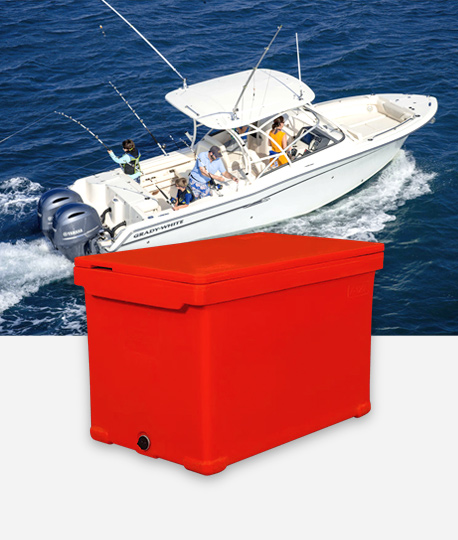Seafood has relatively high requirements for long-term preservation and long-distance transportation, so a variety of different seafood processing methods have been derived, and insulated storage containers for preserving seafood are particularly important. Today we will talk about several common seafood freezing methods.
In order to keep the freshest seafood ingredients, humans have explored a variety of processing methods in the process of ocean fishing to deal with different types of seafood according to different situations. There are three main processing methods: live fresh and chilled fresh, Frozen fresh; and according to the processing location, it is also divided into two types: ship frozen and shore frozen.
First of all, it must be emphasized that fresh seafood, chilled seafood, and frozen seafood (divided into raw frozen and cooked frozen) all have their own advantages. According to the characteristics of different ingredients, mainly choose different processing methods according to the quality of meat, so that each food can show the best taste and flavor, worthy of our selection.
Live fresh, as the name suggests, refers to live seafood. Many people think that fresh seafood is the best because it is the freshest. If you are close to a seafood fishing spot, it is reasonable to ask for live seafood. But if you are inland, or if you want to eat imported seafood, its survival rate and meat quality are difficult to guarantee.
Take the lobster with the most tenacious vitality as an example, the lobster can usually last for about a week in transportation, which is why the lobster can usually be eaten fresh. However, during the transportation process, the lobster lacks food and drink, causing the shrimp meat to shrink and thin. This is why after cooking live lobsters, it is often seen that the meat is separated from the shell, and even the meat of the shrimp claws is only 1/3.
In the past, the most famous restaurant in Beiping processed the crabs that lost their meat and fat after transportation. They had to be fattened to achieve the best taste before serving customers. However, we don’t have such a means now, so it’s best to eat fresh seafood in coastal areas, otherwise, even if the seafood can survive in transportation, the actual taste is much worse than that of seafood processed in other ways.
After the seafood comes ashore, it is covered with crushed ice layer by layer for a short period of time to keep it fresh. The seafood treated in this way is called chilled. Crushed ice can reduce the temperature of seafood to around 0°C and keep it in this temperature range during transportation and storage. In this temperature range, seafood or meat basically does not freeze and can maintain freshness in a short period of time. To put it more bluntly, the seafood that we often see in supermarkets that lie on the ice and do not freeze themselves are all chilled. Seafood processed in this way has a short shelf life and is not suitable for long-distance transportation.
Frozen fresh refers to seafood stored below -18°C after quick freezing. The advantage of frozen freshness is that the core temperature drops rapidly to -18°C to achieve complete freezing, which completely solidifies the water, prevents quality changes caused by fluidity, and ensures the nutrition and quality of seafood. Frozen seafood can lock the nutrients and moisture in the seafood to avoid loss. And it can kill bacteria and prevent bacterial invasion, maintain the original quality of the product, and be beneficial to long-term storage.
Because there may be parasites such as Schizophrenia Grandis in sashimi, sashimi must be frozen at low temperatures to reduce the risk of infection. The US FDA stipulates that fish must be frozen at -35°C for 15 hours, or frozen at -20°C for 7 days It can be eaten raw, and the European Union requires freezing at -20°C for more than 1 day.
Frozen seafood is divided into raw frozen and cooked frozen according to the different meat quality and characteristics of seafood. The advantage of raw and frozen seafood is that it can be cooked in a variety of ways. It is untreated and cooked, so there are more cooking possibilities, but the weight at the time of purchase often contains water, and the cooking time is longer. Aiming at the shortcomings of raw and frozen seafood in terms of weight, Fresh Crazy always insists that raw and frozen seafood is dry and ice-free, and the weight is real, giving customers the best consumption experience.
Cooked and frozen seafood is boiled in salt water and then frozen. Because it is quickly frozen at ultra-low temperatures when the seafood is fresh and plump, it completely maintains the fresh and tender meat quality of the seafood. The shape is complete, the meat is tender, and the cooking time is short. Cooking and freezing are currently one of the most common and stable seafood processing methods.
Some seafood meat is not suitable for raw freezing and must be cooked and frozen to maintain the best taste. Especially seafood with shells such as shrimp, crab, lobster, shellfish, etc., in addition to fresh, is mainly cooked and frozen. Because raw freezing will cause the inside and outside of the cell wall to be unbalanced, and the shrinkage of the meat will affect the taste.
Many of the sashimi we eat every day is actually cooked and frozen, not all raw. I am afraid that Japanese food stores that are not professional enough don't know this. There are two ways to cook frozen, fully cooked, and half cooked. Fully cooked ones are commonly found in various shrimp and crabs, and half-cooked seafood such as arctic shellfish.
We are a professional Seafood Insulated Plastic Accessories Supplier, if you are interested in our products, please contact us.


 English
English Español
Español عربى
عربى 中文简体
中文简体
-4.png)
-4.png)
-2.png)

-2.png)
-2.png)




